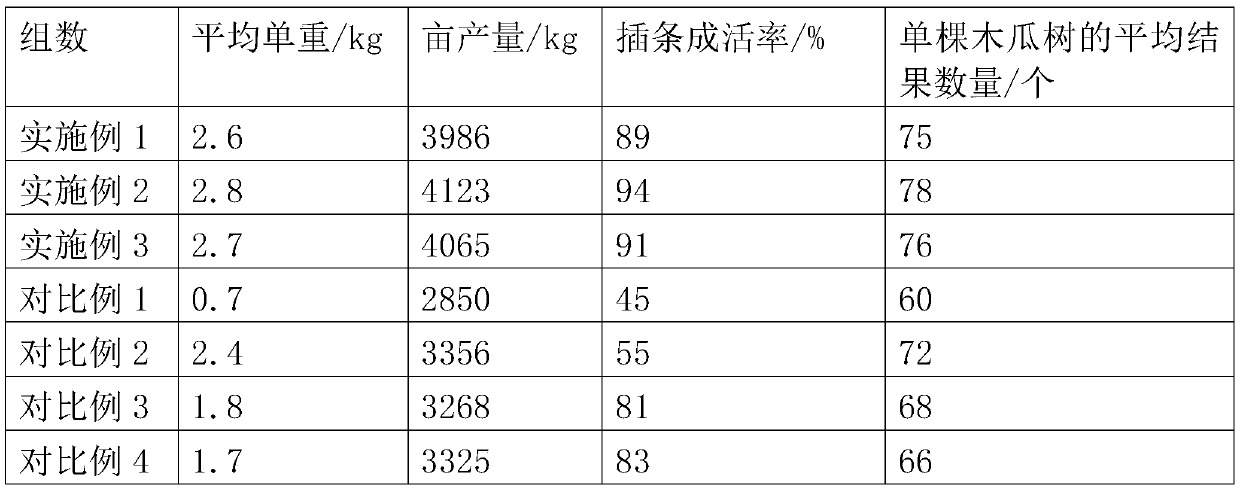Planting method of high-yield papaya
A planting method and technology of papaya, applied in botany equipment and methods, fertilization methods, planting substrates, etc., can solve the problems of increased content of harmful substances in papaya, inedibility, low yield of papaya, etc., to promote rooting, rapid growth and health, The effect of increasing the soluble solid content
- Summary
- Abstract
- Description
- Claims
- Application Information
AI Technical Summary
Problems solved by technology
Method used
Image
Examples
Embodiment 1
[0024] A planting method of high-yield papaya, comprising the steps of:
[0025] (1) Select sandy soil with deep soil layer, loose and fertile, well-drained, sheltered from the wind and sunny as the planting site, plow deeply and remove debris, and cover 3 layers of nutrient matrix, wherein the nutrient matrix includes the following raw materials by weight: decomposed farmhouse 150 parts of fertilizer, 80 parts of soil, 30 parts of coconut peat, 30 parts of bentonite, 20 parts of illite powder, 1 part of trace elements;
[0026] (2) From February to March every year, cut the strong branches from the papaya tree that are 1 to 1.5 years old, uniform in thickness, and the buds are still in the dormant period as cuttings. The upper cut is 1cm away from the base of the leaf, and the lower cut is tight. Cut at 0.5 cm next to the node, each segment contains 2-3 branches;
[0027] (3) Peel and cut the end of the cuttings, then use 0.1% indole acetic acid aqueous solution to soak for ...
Embodiment 2
[0031] A planting method of high-yield papaya, comprising the steps of:
[0032] (1) Select sandy soil with deep soil layer, loose and fertile, well-drained, sheltered from the wind and sunny as the planting site, plow deeply and remove debris, and cover 3 layers of nutrient matrix, wherein the nutrient matrix includes the following raw materials by weight: decomposed farmhouse 180 parts of fertilizer, 90 parts of soil, 40 parts of coconut peat, 35 parts of bentonite, 25 parts of illite powder, and 3 parts of trace elements;
[0033] (2) From February to March every year, cut the strong branches from the papaya tree that are 1 to 1.5 years old, uniform in thickness, and the buds are still in the dormant period as cuttings. The upper cut is 1cm away from the base of the leaf, and the lower cut is tight. Cut at 0.8 cm next to the node, each segment contains 2-3 branches;
[0034] (3) Peel and cut the end of the cuttings, then use 0.1% indole acetic acid aqueous solution to soak...
Embodiment 3
[0038] A planting method of high-yield papaya, comprising the steps of:
[0039] (1) Select sandy soil with deep soil layer, loose and fertile, well-drained, sheltered from the wind and sunny as the planting site, plow deeply and remove debris, and cover 3 layers of nutrient matrix, wherein the nutrient matrix includes the following raw materials by weight: decomposed farmhouse 200 parts of fertilizer, 100 parts of soil, 50 parts of coconut peat, 40 parts of bentonite, 30 parts of illite powder, 5 parts of trace elements;
[0040] (2) From February to March every year, cut the strong branches from the papaya tree that are 1 to 1.5 years old, uniform in thickness, and the buds are still in the dormant period as cuttings. The upper cut is 1cm away from the base of the leaf, and the lower cut is tight. Cut next to the node 0.5-1.2 cm, each segment contains 2-3 branches;
[0041] (3) Peel and cut the end of the cuttings, then use 0.1% indole acetic acid aqueous solution to soak f...
PUM
 Login to View More
Login to View More Abstract
Description
Claims
Application Information
 Login to View More
Login to View More - R&D Engineer
- R&D Manager
- IP Professional
- Industry Leading Data Capabilities
- Powerful AI technology
- Patent DNA Extraction
Browse by: Latest US Patents, China's latest patents, Technical Efficacy Thesaurus, Application Domain, Technology Topic, Popular Technical Reports.
© 2024 PatSnap. All rights reserved.Legal|Privacy policy|Modern Slavery Act Transparency Statement|Sitemap|About US| Contact US: help@patsnap.com








